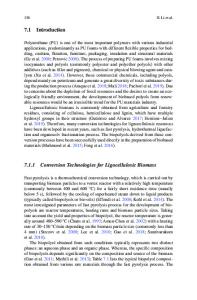Bio-based Polyurethane-Clay Nanocomposite Foams: Syntheses and Properties
- PDF / 670,351 Bytes
- 8 Pages / 612 x 792 pts (letter) Page_size
- 81 Downloads / 361 Views
1188-LL04-05
Bio-based Polyurethane-Clay Nanocomposite Foams: Syntheses and Properties Min Liu1, Zoran S. Petrovic1 and Yijin Xu1,* 1 Kansas Polymer Research Center, Pittsburg State University, Pittsburg, KS 66762, U.S.A * To whom all the correspondences should be addressed. ABSTRACT Starting from a bio-based polyol through modification of soybean oil, BIOH™ X-210, two series of bio-based polyurethanes-clay nanocomposite foams have been prepared. The effects of organically-modified clay types and loadings on foam morphology, cell structure, and the mechanical and thermal properties of these bio-based polyurethanes-clay nanocomposite foams have been studied with optical microscopy, compression test, thermal conductivity, DMA and TGA characterization. Density of nanocomposite foams decreases with the increase of clay loadings, while reduced 10% compressive stress and yield stress keep constant up to 2.5% clay loading in polyol. The friability of rigid polyurethane-clay nanocomposite foams is high than that of foam without clay, and the friability for nanofoams from Cloisite® 10A is higher than that from 30B at the same clay loadings. The incorporation of clay nanoplatelets decreases the cell size in nanocomposite foams, meanwhile increases the cell density; which would be helpful in terms of improving thermal insulation properties. All the nanocomposite foams were characterized by increased closed cell content compared with the control foam from X-210 without clay, suggesting the potential to improve thermal insulation of rigid polyurethane foams by utilizing organically modified clay. Incorporation of clay into rigid polyurethane foams results in the increase in glass transition temperature: the Tg increased from 186 to 197 to 204 °C when 30B concentration in X-210 increased from 0 to 0.5 to 2.5%, respectively. Even though the thermal conductivity of nanocomposite foams from 30B is lower than or equal to that of rigid polyurethane control foam from X-210, thermal conductivity of nanocomposite foams from 10A is higher than that of control at all 10A concentrations. The reason for this abnormal phenomenon is not clear at this moment; investigation on this is on progress. INTRODUCTION The utilization of natural products such as plant oils and natural fats has attracted great attentions in both scientific and industrial areas in recent years, due to both the energy and the environmental considerations. These starting materials are sustainable, renewable, and most importantly, biodegradable. Rigid polyurethane foams have been widely used for insulation purposes due to their better thermal properties than those of thermoplastic foams and other common insulation materials. It has been confirmed that polymer-clay nanocomposites show improved thermo-mechanical properties, better scratch resistance, improved gas permeation property, higher glass transition and stiffness, and better flame retardancy. Starting from a biobased polyol through modification of soybean oil, a series of bio-based polyurethanes and their clay nanocomp
Data Loading...











